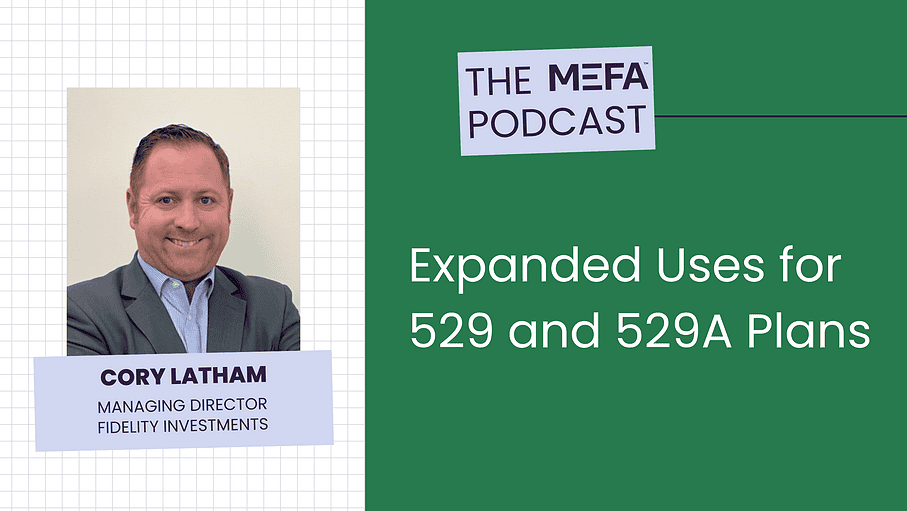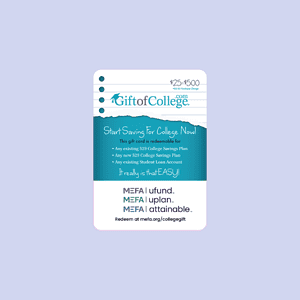Resources Mentioned in this Episode
Jonathan Hughes: [00:00:00] So let’s talk about the credentialing programs now.
Cory Latham: So what it does, this bill expanded qualified higher education expenses that can be distributed to include qualified post-secondary credential expenses. So what are some of those tuition fees, books, supplies, and equipment required for enrollment or attendance of a beneficiary in a recognized post-secondary credential program, or any other expense occurred in connection with enrollment or attendance?
Within that recognized post-secondary credential program. Other things are fees for testing that’s required to obtain or maintain a recognized post-secondary credential or fees for continuing education that’s required to maintain a recognized post-secondary credential.
Jonathan Hughes: Okay.
Cory Latham: Yeah. Which I think would [00:01:00] lead to the question of what’s a recognized post-secondary credential?
Jonathan Hughes: Exactly. Yeah. Recognized by whom, right? Yeah. Yeah.
Cory Latham: I have an answer.
Jonathan Hughes: Good.
Hi everyone and welcome to the MEFA Podcast. My name is Jonathan Hughes, and you just heard from our guest on the show today who is here to tell us all about some really sorely needed good news because we always need. Good news, but we definitely do when it comes to saving and that is what we’re going to be talking about.
So new expansions for 529 plans. These were expansions that were just recently signed into law this July. And they signal all of these new things that you can use your 5 29 plans for. That’s both. Educational or traditional 529s and 529a or ABLE accounts. And so this is some really good news as well for folks with ABLE accounts.
I’d love to tell you all about what they are, but I’ll let our guests take care of that. But before we go. I want to tell you of course that I’ll be back after the interview [00:02:00] to wrap things up, but even before that, I want to take a minute and ask anyone listening or watching to do me a favor. And that favor is to please go and leave us a good review as it just helps us to keep bringing you this show.
Now, I’ll be sure to remind you again when I bid you farewell after the interview. But for now, let’s welcome our guest and talk all about these great new 529 and ABLE benefits.
Cory Latham: Yeah, so thanks John. So my name is Corey Latham. I am a managing director at Fidelity Investments and I work directly with MEFA on both the Youth fund and the Attainable Savings Plan.
Jonathan Hughes: Yeah. Thank you. And thank you for coming back to talk about the, the expansion of 5 29 benefits that, that we saw recently passed and the big beautiful bill as they call it. But before we actually get to that, I was wondering if you could just bring everybody up to speed before then and talk about what were qualified expenses, first of [00:03:00] all, what’s meant by qualified expenses, and then what did that encompass up until this recent expansion?
Cory Latham: Yeah, and I think happy to cover it. I think what’s great to know is that all of these are add-ons and there really isn’t anything that’s been taken away. So I think it’s always that’s always what we want to see. The more options you have, the better. So when we’re talking about qualified expenses, I’ll explain how the 529 works.
So money in that account grows tax deferred, and as long as you use the money in that 529 account for what is considered a qualified expense, and I’ll list what those are. The distributions of that are gonna be federal tax free. So you get tax free growth, which is important, and that’s why we always talk about starting early, saving for a long time.
That growth, again, as long as you’re using it for what’s qualified, you don’t have to pay any federal taxes on that. So what does that include? A lot of it was really focused on what’s higher education expenses. So you think typically about college? College tuition, college room and [00:04:00] board books, computers, supplies, things like that.
Those are all covered as qualified expenses. There’s been recent expansions, things like trade schools, apprenticeship programs. That’s one of the big ones. There’s a student loan repayment option right now that’s $10,000 lifetime for a beneficiary. And there’s also K through 12 expenses which.
Prior to the passing of this recent legislation was simply just tuition. But as a part of this recent legislation, it’s become significantly more expanded.
Jonathan Hughes: Yeah. And that’s something that I’ve used it for K through 12 tuition and I’m looking to to, to use it for more of it in the upcoming year.
So it’s something that, that is important to me. So I was glad to see that. So that was what was meant by eligible expenses up until. The passage of this bill on July 4th. So what were the new expenses? And so some of them took effect immediately, and some of them are a little bit later on. So can we [00:05:00] start with the ones that took effect immediately on July 4th?
Cory Latham: Yeah, of course. And I’ll say there’s a lot of information right now. It’s gonna be pretty dense. I’m going to do my best to hopefully have it all make sense.
Jonathan Hughes: Okay.
Cory Latham: So there are a couple different key areas in the bill that we’re really focusing on was one was around that K through 12, those usage and the expanded uses that we have.
The other one was really around credentialing programs. So know, we’ll talk about that. Those are really the two big. Key areas. So what went into effect now is the expansions, or sorry, on July 4th, right? Are the expansions of those K through 12 and the expansion of being able to use it for certain credentialing programs, the one that’s going to go in effect into later into 2026.
And that tax year is the amount. So currently the amount for K through 12 expenses is $10,000. That’s going to actually expand to $20,000 per year. That doesn’t go into effect until the next tax year. So beginning [00:06:00] 2026.
Jonathan Hughes: So what does take into effect for K through 12?
Cory Latham: Yeah, so we, we mentioned earlier that it was simply just tuition, like that was the big one, and now it’s being able to be utilized for a lot more.
So what it really focuses on is expenses that are in the connect, that are in connection with the enrollment and attendance at an elementary school or secondary school. So what are some of those things? It’s curriculum or curriculum materials, books or instruction materials, online education materials.
Tuition for tutoring or classes outside the home. Certain conditions have to be met for that. Fees for nationally standardized achievement tests, advanced placement exams, college admissions exams and also like certain educational therapies for students with disabilities, so occupational, behavioral, physical speech, language, therapies.
What it’s really done is for those folks that. Are looking to use 529s earlier than [00:07:00] most typically would around college. It’s saying that we understand that there’s a lot of other expenses that are associated with that earlier education you want to be used. And what this bill tried to do was meet what some of those needs were and not really just be as restrictive as it had been from tuition.
Jonathan Hughes: Yeah, that’s really good news.
Cory Latham: Yeah, it is. The more options you have, the more expanded uses that you have, the better that these accounts. I think the point of having an account like this is you want to meet the needs of that beneficiary. Yeah. And then it’s hard to know what the need of your beneficiary is going to be when they’re born.
Jonathan Hughes: Right.
Cory Latham: It’s hard to even know probably what that need is by the time they get to be a JT. I think like you’re trying to figure it out throughout, so the more options that you have, the more that’s available to you, the better that plan can work for you.
Jonathan Hughes: And so let’s talk about the credentialing programs now.
Cory Latham: Yeah.
Jonathan Hughes: Big one.
Cory Latham: So yeah it definitely is. And this one is a little dense. I don’t know if you’ve used that quite. Guys, I’ll explain it and then we can talk about it a little bit [00:08:00] more. So what it does, this bill expanded qualified higher education expenses that can be distributed to include qualified post-secondary credential expenses.
So what are some of those tuition fees, books, supplies, and equipment. Required for enrollment or attendance of a beneficiary in a recognized post-secondary credential program or any other expense occurred in connection with enrollment or attendance within that recognized post-secondary credential program.
Other things are fees for testing that’s required to obtain or maintain a recognized post-secondary credential or fees for continuing education that’s required. To maintain a recognized post-secondary credential.
Jonathan Hughes: Okay.
Cory Latham: Which, yeah, which I think would lead to the question of what’s a recognized post-secondary credential?
Jonathan Hughes: Exactly. Yeah. Recognized by whom, right? Yeah. Yeah.
Cory Latham: I have an answer.
Jonathan Hughes: Good.
Cory Latham: So it’s any industry recognized postsecondary credential, it’s a [00:09:00] certificate or completion. Of an apprenticeship that is registered and certified with the Department of Labor under the National Apprenticeship Act. Any occupational or professional license issued or recognized by a state or federal government that satisfies the condition for obtaining a license.
So what are some of those? It’s probably easier to think of through examples.
Jonathan Hughes: Yes. Yeah, I was just about to ask you.
Cory Latham: Yeah, so I think you’re thinking things like, Hey, the bar exam, right? That’s a big one. You think about things like a certified financial planner or a certified public accountant, things like that.
Those qualify. Qualify, but it’s a lot broader than that. So one of the ones that you maybe wouldn’t think of, but definitely qualifies would be someone getting their CDL, the commercial driver’s license. So the ability to get that, to be able, the ability to do whatever the continuing educations are as a part of that is another one that does qualify.
So it’s not just those typical ones you think of that are related to. More like financial professional type activities. It’s broader than that. So I think I bring up CDL as an [00:10:00] example because that’s an interesting one that, it’s really that expanded uses that you’re seeing with the trade schools and the apprenticeship programs and really looking at meeting people where they are. So very broad.
Jonathan Hughes: I would What about something like, I’m going to throw some at you and I don’t know if you can tell me if you know what about something like HVAC.
Cory Latham: Yeah, as long as it follows that credentialing area and it’s recognized by one of those boards, like the National Labor Board, things like that, I’d always recommend you check on that.
But it has been expanded to opportunities such as that. So that’s what you’d want to do, is you’d want to go in and look and make sure that it qualifies as a registered apprenticeship program, trade school. And it should give you that information right now, but it is two more positions and roles that are like that.
That aren’t simply just the education portion of it, more kind of those actual like real life usage of it. We have seen that expand for sure.
Jonathan Hughes: Wow. Okay. So those are the things that took effect [00:11:00] immediately upon signing the bill July 4th. Yep. Exciting expansions. What is on the horizon for the future?
Cory Latham: So there’s a couple ones. I mentioned the expansion of the amount, like that’s a big one. It’s basically doubling from $10,000 to $20,000 that goes live. And I also wanted to, we talked about, spend some time talking about how it’s going to impact able accounts.
Jonathan Hughes: Yes, we certainly will.
Cory Latham: Yeah. So there’s one, I think that’s a good, give you a professional transition.
One that worked well for 529s and ABLE, so the fact that you can do a rollover. From a 529 account into an ABLE account that was in existence, you could do that. But what was going to happen was at the end of this tax year that was going to expire. So what this legislation did, what this bill did was that made it permanent.
So that’s a big deal. That’s a big deal for both the 529 and the able space that there was a lot of talk about, is this going to go [00:12:00] away? Why would it go away? No one really wanted it to go away and this bill made that permanent. So you are able to do a tax free rollover from a 529 to an ABLE account if the beneficiary qualifies for it, and that’s how you want to utilize those funds.
Jonathan Hughes: So now that you mention it, I wonder if you could set the table on able accounts like you did for 529s. What are those?
Cory Latham: Yeah, so starting out, what is an able account? So it’s a tax advantage account for those with disabilities, they say for both short and long-term expenses. There’s a coup- there’s a lot of benefits.
I’ll focus on the two biggest ones. So the first is you get that tax deferred growth that we mentioned in a 529. It works the same way. The difference is we’re a 529s for a qualified education expense. Enable account is for qualified disability expense. So that is very broad of what that can be utilized for.
You want to make sure for the health wellbeing to maintain that for the beneficiary, [00:13:00] but again, you maintain that tax deferred growth, tax-free distributions for that. And another big one is that it allows the beneficiary to be able to save. So you can save up to a hundred thousand dollars in an ABLE account and it will not have an impact on any federal benefits that somebody may be receiving.
I’ll also say when we’re talking about able, that’s the overall account when we’re talking about what’s offered through MEFA and with Fidelity is the attainable savings plan. So that’s the one that we have.
Jonathan Hughes: Right, that is the sort of equivalent to the U Fund for 529 The attainable for-
Cory Latham: Right way to think about it. Yeah, exactly.
Jonathan Hughes: Yeah. Okay. So that’s great. And I know that it was something that was happening and I’m really glad to see that was made permanent. And it’s interesting you say nobody really wanted that to go away, which no. Yeah, I couldn’t imagine why they would. So it’s good that, yeah. When there’s something that nobody wants to happen, we can avoid it.
Cory Latham: That’s, no, it also made a, another, a few other things permanent. I’ll touch on those too. I think that are good to know. So there’s also one called [00:14:00] Able to Work. So what that does is it allows people who have an able account and are working and are not actively contributing to a retirement account.
You can contribute above the set amount to enable account each year. So there is a set amount that you can contribute to enable account every year. But if you work and again, aren’t contributing actively contributing to that retirement, then you can put more money in that able account so that again, that was in existence right now and the was going to sunset at the end that has been made permanent.
So that’s another big win in that able space to allow those people who are working to be able to save more, a little bit more within that account. Another big win for those able Savers from this legislation.
Jonathan Hughes: Yeah, and I know it’s not part of this legislation, but there is another maybe we should just mention it anyways, that there’s another big change with ABLE that’s coming in 2026, right?
Cory Latham: Yeah. Yeah. A big one. I like that one. So what it is [00:15:00] currently, right now, I guess it depends when you’re listening to this, reviewing this, but is that we’re recording it today. The onset of the disability to be eligible for an ABLE account is age 26, so that doesn’t mean the account has to be opened by then.
It just means that the onset of the disability has to have occurred by then beginning 2026. That extends out to age 46. That’s another 20 years for individuals who could have developed a disability at any point during their life during that timeframe. They are now eligible to open up an able account and take advantage of all of those benefits so that will open up a massive amount of the population who would be eligible for one.
So that very excited for that. Very excited to have those who could really benefit from the account, be able to do. Simply due to the fact that the age has now been expanded out to age 46.
Jonathan Hughes: Yeah. And so just to wrap things up if anyone [00:16:00] is listening to this and they have a youth fund, or if they have an attainable account and they’re thinking maybe that they could use and take advantage of one of these recent expansions and use their youth fund or attainable in a new way yeah, but they have questions. What should they do? Who should they consult?
Cory Latham: Yeah, a lot of resources out there. I think. I know Jonathan, you at Beef have a ton of resources that are available for people to be able to utilize at Fidelity. If you’re interested in the U Fund, it’s fidelity.com/u fund. If you want to learn more about ABLE or the attainable plan, it’s fidelity.com/attainable.
In addition, we also have dedicated specialists that you could contact, so they’re here from Monday. 8:00AM to 9:00 PM They focus on 529 savings, ABLE savings. So a lot of different and there. And there’s also a lot of great resources out there that you can educate yourself on and read. Those are the ones that we have for you.
And you do always want people to learn about. [00:17:00] Learn as much as you can so that when you’re making those decisions to open up the account, manage the account that you really do understand what. You’re doing.
Jonathan Hughes: Yeah. And Fidelity has obviously done a great job for the, you funded for Attainable and managing those accounts and providing service.
So we really appreciate that and personally as a customer, appreciated as well. Is there anything else that I haven’t asked that you think is important for folks to know?
Cory Latham: I would say, Jonathan, when it comes to this, right now, I think it’s all, it’s still new. I think that this is all within the last few months that this has come out.
Just make sure that you’re educating yourself on it is an important one. Especially when we talked about that credential program. I think that’s a really interesting one is that what does it mean? What does it qualify? Since it’s so much more expansive. If you’re interested in, you think that it could qualify, check it out and I do think what this does though is, one of the things we’ll hear a [00:18:00] lot with 529 plans are, I don’t know if my child’s going to go to college, so they’re not going to use it. We’ve been talking for a little bit a while. We haven’t really said college. We’ve talked about a lot of things that it can be utilized for outside of that, so absolutely can be used for those expenses. It’s a lot of ways built for those ones.
So that’s the majority of what you’re going to see, but that’s not it, right? So that it’s a lot more broader. So if the reason why you didn’t want to open up a 529 was because you couldn’t. Guarantee your child was going to do that, there’s probably a good chance they’re going to be utilizing one of the things that we had mentioned, if not that.
A lot of benefits to get started early. Take advantage of compounding growth, right? Things such as that. I think what 529 plans have been doing recently is really just expanding to be more useful for the populations that’s needing it, right? I think that’s what you want to do with anything. The 529 plans in legislation has done a really good job of that over the last few years.
Jonathan Hughes: Thank you so much, Corey.
Cory Latham: Thanks for having [00:19:00] me.
Jonathan Hughes: All right. Thank you so much, Cory. It was great to see you again, and I really do appreciate you coming on to talk to us all about these exciting new developments of folks. If you liked what you heard today on the show and you want to hear more from us about planning, saving, and paying for college and career.
Training. You can follow the show and you can do that wherever you find your podcast. And please, once again, I’m going to remind you to leave us a good review, rate us and review us. It just helps us once again, to keep doing what we’re doing in getting this show out in front of folks like you. I would also like to thank our producer, Shaun Connolly.
I would like to thank Lisa Rooney. Lauren Danz, Christina Davidson. Meredith Clement and AJ Yee for their assistance in posting the show so that you can all [00:20:00] actually watch or listen to it. Once again, my name is Jonathan Hughes and this has been the MEFA Podcast. Thanks.













